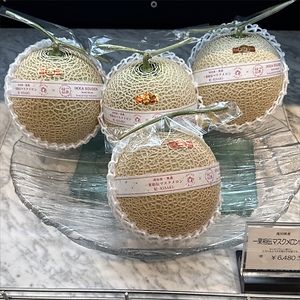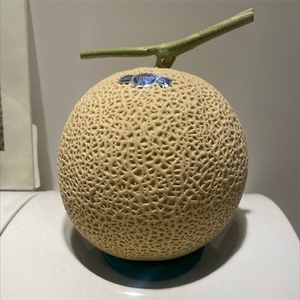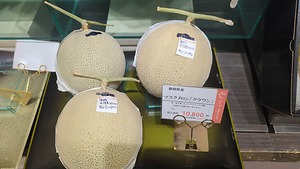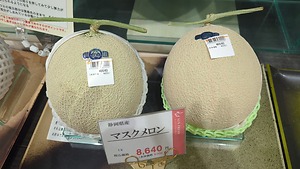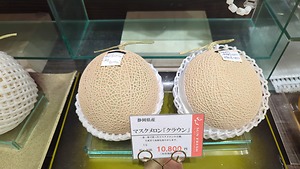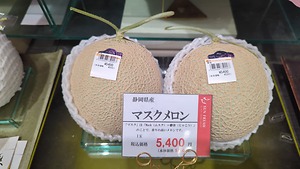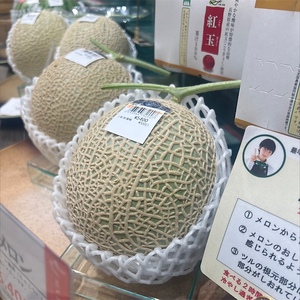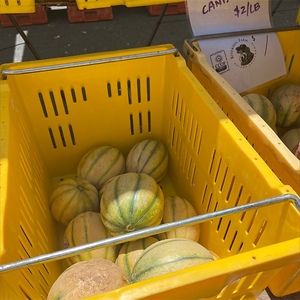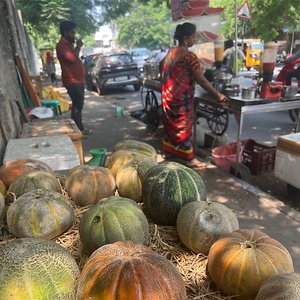


Muskmelons
Estimated Inventory, lb : 0
Description/Taste
Muskmelons vary in shape and size, depending on the specific variety, and are generally round to oblate with a bulbous to slightly flattened shape. The melon's rind can be thick or thin and showcases various textures ranging from smooth, rough, netted, to scaly. Muskmelons appear in solid or striped shades of white, tan, beige, yellow, grey-green, green, to orange, and the surface is either level or covered in sutures, giving the rind an indented to shallowly creased nature. Netted muskmelon varieties exhibit a raised, corky covering that envelops the melon's entire exterior. The netting can be prominent or fine, contributing a rough feel, and smooth Muskmelon varieties should feel somewhat velvety rather than glossy. Underneath the surface, the flesh is orange, white, green, salmon, to pale yellow and is typically thick, fine-grained, and dense with an aqueous nature. Some Muskmelon varieties will be soft, tender, and succulent when ripe, while others will remain firmer with a subtly crisp consistency. The flesh also encases a central cavity filled with flat, tear-drop-shaped, tan seeds suspended by stringy white fibers. Select Muskmelons that emit a perfumed, musky aroma, feel heavy for their size, and have a slight give around the stem scar when ripe. They will also release a dull, low-pitched thud when tapped. Ripe Muskmelons are edible raw or cooked, and depending on the variety, the melons have a sweet, floral, musky, and honeyed taste or are milder in nature with subtly sweet, grassy, and watery flavors.
Seasons/Availability
Muskmelons are generally available in the spring through summer. Some varieties may be grown year-round in select climates.
Current Facts
Muskmelons, botanically classified as Cucumis melo, are a category representing several melon varieties belonging to the Cucurbitaceae family. Scientists label most melons within the Cucumis melo species as Muskmelons, and the varieties within the species differ in size, appearance, texture, and flavor. Muskmelons are also known as Sweet melons, and well-known types of Muskmelons within Cucumis melo include Cantaloupes, Honeydews, Persian melons, Casaba, Spanspek, Santa Claus melons, Galia, and Crenshaw melons. Muskmelon is a broad term used interchangeably for many different types of melons grown worldwide for fresh markets. The Muskmelons featured in the photograph above were sourced from India. There are many commercial varieties of Muskmelon grown in India today, with notable varieties such as Hara Madhu, Arka Rajhans, Pusa Madhurima, Durgapura Madhu, Pusa Rasraj, Arka Jeet, Pusa Sharbati, Punjab Sunehri, Punjab Hybrid, and numbered cultivars MH-51, MH-27, and MH-10. Indian Muskmelons develop on sprawling, climbing vines extending 1 to 2 meters in length and are a warm-season crop harvested for sale in fresh markets. The varieties are favored for their aromatic scent, sweet flavor, and juicy flesh, typically consumed fresh, out of hand, or incorporated into an array of sweet and savory preparations.
Nutritional Value
Muskmelons are a source of fiber to regulate the digestive tract, potassium to balance fluid levels within the body, and vitamin K to develop proteins for improved wound healing. The melons also provide vitamin C to strengthen the immune system and reduce inflammation, vitamin A to maintain healthy organ functioning, folate to create genetic material, magnesium to control nerve operations, and antioxidants to protect the cells against the damage caused by free radicals. In Ayurveda, a holistic healing system practiced in India, Muskmelons contain cooling properties and high water content to replenish bodily fluids, reduce fatigue, and improve overall health.
Applications
Muskmelons vary in flavor from sweet, musky, and perfumed to mild, somewhat bland, and subtly sweet, depending on the variety, and are suited for fresh and cooked preparations. The melon's flesh also ranges from firm and crisp to juicy and succulent, and this textural component will determine what recipes the variety is used in. Soft and juicy Muskmelons are typically consumed straight out of hand and can be sprinkled with black salt, sugar, or cardamom for enhanced flavoring. Slices of the melon are also topped with yogurt and mint as a refreshing appetizer, breakfast, or snack. Try slicing and tossing the flesh into salads, using it as a topping over pancakes, parfaits, or ice cream, or pureeing it into chilled soups. Firmer-fleshed Muskmelons can be chopped into salsas, balled and mixed into fruit bowls, or wrapped in salty cured meats. Muskmelons, in general, can be made into sauces, blended and frozen into sorbet and popsicles, or pureed with other ingredients to make a pudding. In India, Muskmelons are popularly used to flavor lassis, milkshakes, smoothies, and juices. Some types of Muskmelons are also used for curries and sabzi, a stir-fried dish of vegetables, melon, and spices. Muskmelons pair well with fruits such as papaya, mango, kiwi, oranges, and coconuts, honey, spices including cardamom, cumin, nutmeg, cinnamon, and coriander, ginger, and herbs such as lemongrass, mint, dill, or basil. Whole, unopened Muskmelons should be kept at room temperature until mature. Once ripe, the melons should be immediately consumed for the best quality and flavor. Sliced pieces of the flesh will keep for 2 to 4 days when stored in a sealed container in the refrigerator.
Ethnic/Cultural Info
Indian Muskmelons are famous in Southern India for their use in panaka or panakam, a traditional cooling beverage. Panaka is customarily served during Ram Navami, an annual festival honoring Lord Rama, the incarnation of Lord Vishnu. Ram Navami celebrates the birth of Lord Rama and usually falls sometime in March or April, depending on the Hindu calendar. During the festival, families gather at temples and recite portions of sacred texts, chant Vedic mantras, give fruits as offerings to the gods, and attend parades where representations of Rama and his wife are carried through the city streets. March and April are traditionally hot months in Southern India, so it is a tradition at gatherings to serve nutritious and cooling beverages to keep the body hydrated and healthy. Panaka is one of the most popular beverages served during Ram Navami, and the melons are blended with lime juice, jaggery, pepper, and cardamom to create a bright, sweet, and spiced drink. Panaka is also served alongside a bowl of sliced Muskmelon to further offer a cooling reprieve from the heat.
Geography/History
Muskmelons are thought to be native to the Trans-Caucasus region and Persia, now modern-day Iran, and have been cultivated since ancient times. There is some debate surrounding the origins of Muskmelons due to their variation, widespread presence, and absence as a wild species. Scientists also recognize a secondary center of origin encompassing Afghanistan, Kashmir, and the northwest provinces of India. Muskmelons were selectively bred and cultivated as a food and medicinal ingredient throughout Western Asia, and over time, the species spread across trade routes into Central, Southeast, and East Asia, and into Europe. Muskmelons were present in Ancient Greece and Rome, and by the 15th and 16th centuries, select varieties were being grown in Spain. Melon seeds were also carried to the New World with Spanish and Portuguese explorers, spreading as far as California in the late 17th century. Today Muskmelons are grown worldwide in warm, sunny regions. In India, Muskmelons are primarily grown in the states of Maharashtra, Tamil Nadu, Andhra Pradesh, Punjab, Uttar Pradesh, Lucknow, and Telangana. Many of the commercial varieties of Muskmelons in India were bred and released in the late 20th century, and were created at Punjab Agricultural University in Ludhiana, the Indian Institute of Horticultural Research in Bangalore, and the Indian Agricultural Research Institute or Pusa Institute in New Delhi.
Recipe Ideas
Recipes that include Muskmelons. One







